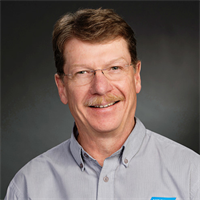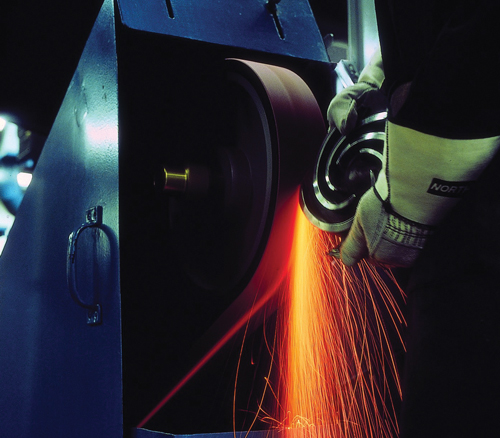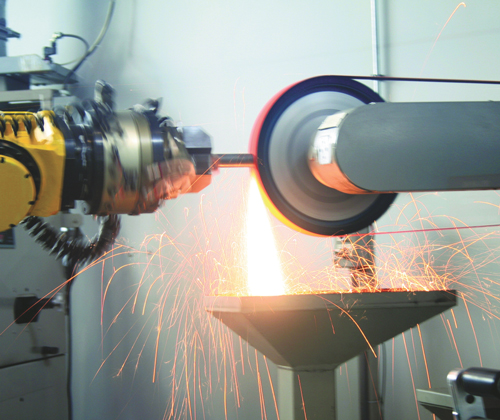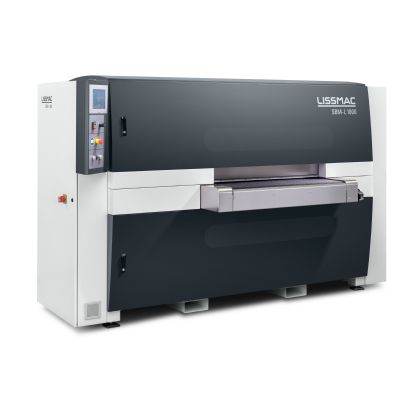High Belt Tension
- Abrasive belt tracking problems. Here, high tension overwhelms the tracking cylinder, which typically is much smaller than tension cylinders.
- Premature bearing wear on the head’s drive, tracking, and/or idler rolls. The higher the belt tension on any type of grinding/sanding equipment, the more wear on all related bearings. This results from the over-tensioned abrasive belt pulling the OD of the rolls or roll shafts against the outer race of the bearings at higher pressures than recommended. This creates higher pressure between the ball/rollers and the inner and outer bearing races, resulting in dangerously high bearing temperatures, followed by bearing failures. On sanding operations that develop combustible particulate, such failures can become fire hazards.
- Belt breakage. High belt tension reduces the belts ability to absorb high or fluctuating shock loads. Breakages will occur in the body of the belt or in the joining area.
- Increased wear on all rolls within the head. This type of wear typically will be located where the abrasive belt tracks back and forth toward the outside edges of the rolls. However, with higher belt tension wear increases excessively.
Watch Pressure Gauges and Regulators
- For steel or hard-rubber contact roll heads, use 20 to 25 lb. of pressure per linear inch of belt width.
- For combination heads and platen heads, use 15 to 20 lb. of pressure per linear inch of belt width.
However, should problematic conditions exist even with the gauge pressure set at its recommended psi, check the air gauge for accuracy. Inaccurate gauges have been directly linked to issues that cause expensive, unscheduled downtime.
To check the air gauge for accuracy, have maintenance personnel convert a standard air regulator to a working measurement tool. Here, the regulator must have two output ports and one inlet port. Fit the inlet port with an air plug that matches the coupler on the air line closest to the grinding/sanding equipment. Fit one of the outlet ports with a quality air gauge in good condition, preferably a glycol-filled gauge that is much less likely to lose its accuracy or be affected by environmental conditions. The second outlet port should be fitted to accept the threads of the belt-tension air gauge.
With such a tool available, thread the air gauge to be tested into its proper outlet port and plug the air supply line into the regulator. Check the air pressure readings between the ‘good’ gauge and the ‘suspect’ gauge at various psi settings to determine accuracy. When not in use, store the measurement tool in a secure place where it cannot be tampered with or disassembled.
Besides belt-tension air gauges, their related air regulators also are key to the condition of grinding/sanding equipment. Leaking or poorly operating air regulators have a direct effect on the air supply to the tension cylinders. Sometimes they can cause high belt tension—unregulated air routing to tension cylinders—or low tension due to insufficient air-pressure supply. Periodically check all regulators to ensure good working order.
Air Leaks Affect Belt Tension
Air leaks also can play a role in abrasive-belt tension problems. Leaks can occur in the air-supply system as well as in the seals of the tension cylinders themselves. Problems caused by these leaks, and the cost of consumed compressed air due to leaks, are commonly underestimated. All air leaks should be repaired, and it is advisable to conduct an air audit throughout your facility. This is a relatively inexpensive way to make the compressed-air system more efficient, which in turn will increase productivity and improve any processes that rely on compressed air. MF
Technologies: Finishing











